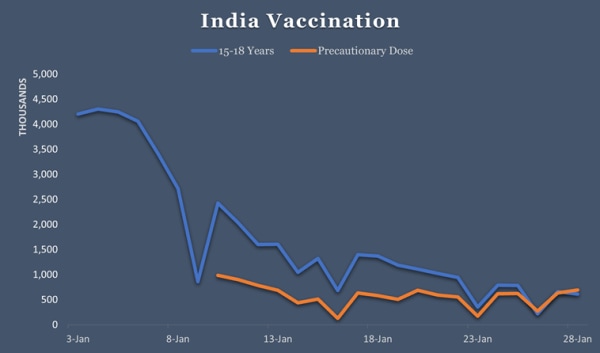6 Vaccines Medicare Covers for Older Adults in 2025


After close to 60 per cent of the population in the 15-18 age group have received the first dose of a Covid-19 vaccine, the pace of vaccination in this group has slowed down considerably.
In the last one week, just about 6.25 lakh people in this age group were vaccinated every day on average, a fraction of the over 40 lakh per day who got jabbed during the first week of this month after vaccination for adolescents below the age of 18 years was opened up.
So far, more than 4.5 crore individuals in this age group have received their first doses. India is estimated to have between 7.5 crore to 8 crore adolescents in the 15-18 age group.
The slowing down of the vaccination is not entirely unexpected. It is largely in keeping with the trends observed for the vaccination for adults as well. The progress of vaccination in any population group typically goes down once the vaccination level reaches the halfway mark.
Newsletter | Click to get the day's best explainers in your inbox
However, the fall in the demand for vaccines in the 15-18 age group has been much sharper than for the adult population.
One reason for this could be the lack of urgency. The Omicron variant of the coronavirus that is powering the current wave of infections is not causing serious disease, especially in the younger age group, and the vaccines have been found to be largely ineffective in preventing Omicron infections.
In the more vulnerable age groups by contrast, the demand for vaccines has been relatively stable.
 The dip in the demand for vaccines in the 15-18 age group is much sharper than for the adult population.
The dip in the demand for vaccines in the 15-18 age group is much sharper than for the adult population. About 5 to 6 lakh people are receiving booster doses every day on average. This is not very different from three weeks ago, when the booster doses, which are being called "precautionary doses" in India, were started for frontline and healthcare workers, and citizens above the age of 60.
There are more than 10 crore people in India older than 60 years of age, and more than 70 per cent of them are fully vaccinated. But not all of them are immediately eligible for the booster dose.
Only those who have completed nine months after their second dose, or those with comorbidities, are currently eligible for the booster shot. Even in this group, those getting infected during the third wave have to wait for a few weeks after recovering.
As on Friday, India had administered more than 165 crore doses of Covid-19 vaccines, which was about 16 per cent of the number globally. According to the Our World in Data project, an initiative by researchers from the University of Oxford, more than 10 billion doses of Covid-19 vaccines have been administered worldwide so far.
However, there have been vast inequalities in the coverage of vaccination.
Over 60 per cent of the world's population has received at least one dose of a Covid-19 vaccine, but Africa, which has 54 countries with a combined population comparable to that of India, has so far administered just about 350 million doses. That translates to about one dose for every four persons.
The poorest countries in the world have together been able to give less than 100 million doses so far.
In contrast, some countries like Israel have been offering a fourth dose to their citizens. China has administered close to 3 billion doses of vaccines to its people. About 1.2 billion doses have been administered to people in Europe, while the United States has given close to 540 million vaccine doses till now.
Over 1 billion doses of vaccine has been delivered through the Covax facility, a joint effort of the World Health Organisation and some other international groups to ensure affordable and equitable access to Covid-19 vaccines for all.
Comments
Post a Comment